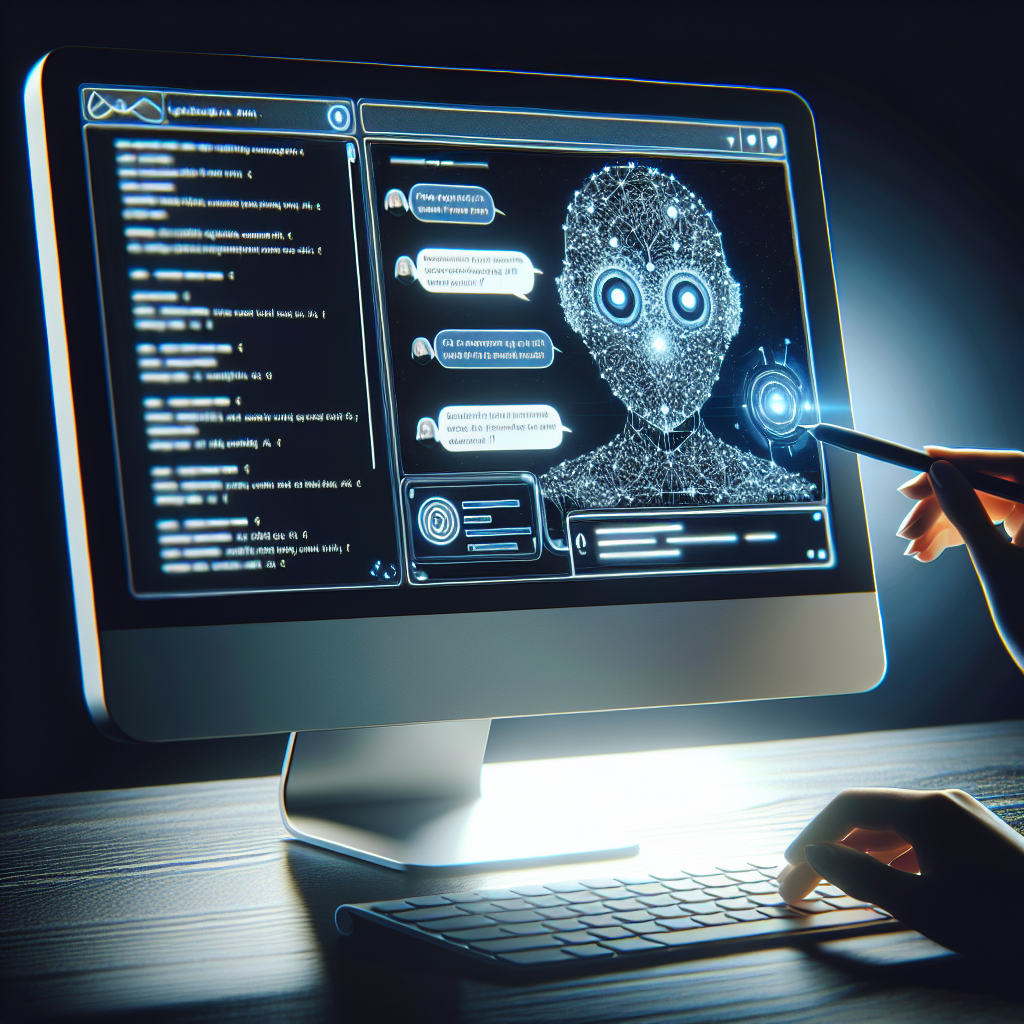Artificial Intelligence (AI) has rapidly evolved over the past few years, transforming various industries and revolutionizing the way we live and work. As we step into the future, advancements in AI tools continue to accelerate, bringing about exciting possibilities and opportunities. From sophisticated chatbots and voice assistants to advanced data analytics and image recognition systems, the future of AI tools holds immense potential for businesses, individuals, and society as a whole. In this article, we will explore the landscape of AI tools, discussing the key trends, innovations, and breakthroughs that we can expect in the near future, and the profound impact they will have on our daily lives.
Evolution of AI tools
Origins of artificial intelligence
Artificial Intelligence (AI) has its roots in the 1950s, with the initial aim of developing machines that can mimic and simulate human intelligence. The concept of AI was born out of the desire to create machines that could perform tasks that typically require human intelligence, such as problem-solving, decision-making, and learning. Early pioneers of AI, like Alan Turing and John McCarthy, laid the groundwork for the development of AI tools and algorithms that would revolutionize various industries in the years to come.
How AI tools have evolved over time
Over the years, AI tools have undergone significant advancements in terms of both capability and accessibility. In the early years of AI, the focus was primarily on rule-based systems, where machines followed predefined rules and instructions. These systems had their limitations as they were often rigid and unable to adapt to new situations or inputs.
However, with advancements in machine learning and deep learning algorithms, AI tools have become more sophisticated and capable of learning from vast amounts of data. This has led to the development of AI tools that can recognize patterns, make predictions, and even exhibit human-like behavior in various domains.
Influential breakthroughs in AI tool development
Several breakthroughs have shaped the evolution of AI tools. One significant breakthrough was the development of neural networks in the 1980s, which allowed machines to learn and improve their performance based on training examples. This breakthrough led to the development of deep learning algorithms, fueling advancements in computer vision, natural language processing, and speech recognition.
Another influential breakthrough was the introduction of reinforcement learning, which enables machines to learn through trial and error and optimize their decision-making processes. This breakthrough has had a profound impact on fields such as robotics and autonomous systems.
The advent of big data and the development of more powerful computing systems have also played a crucial role in the evolution of AI tools. The ability to process and analyze vast amounts of data in real-time has opened up new possibilities for AI applications across various industries.
Current status of AI tools
Current applications of AI tools
AI tools have found applications in a wide variety of industries and domains. In healthcare, AI is being used to improve diagnostics, develop personalized treatment plans, and analyze medical imaging data. In finance, AI tools are used for fraud detection, algorithmic trading, and risk assessment. In manufacturing, AI tools optimize supply chains, enhance quality control, and enable predictive maintenance.
Furthermore, AI is transforming the customer service industry through the use of chatbots and virtual assistants. It is also revolutionizing transportation and logistics with the development of self-driving cars and intelligent routing algorithms.
Industries heavily reliant on AI tools
Several industries heavily rely on AI tools to gain a competitive edge. One such industry is retail, where AI is used for demand forecasting, personalized recommendations, and inventory management. E-commerce platforms utilize AI algorithms to provide personalized experiences to customers, resulting in higher customer satisfaction and increased sales.
Another industry harnessing the power of AI is cybersecurity. AI tools can analyze massive amounts of data to detect and respond to cyber threats in real-time. The ability to identify patterns and anomalies in network traffic or user behavior helps organizations proactively safeguard their systems and data.
The media and entertainment industry has also embraced AI tools for content generation, recommendation systems, and audience analytics. AI algorithms can analyze user preferences, engagement patterns, and social media trends to recommend personalized content, resulting in a more immersive and enjoyable experience for users.
Limitations of present AI tools
Despite the advancements in AI, current AI tools still have limitations that need to be addressed. One significant challenge is the lack of transparency and interpretability of AI algorithms. Deep learning models, for example, may generate accurate predictions, but the decision-making process behind those predictions is often opaque, making it difficult to fully understand and trust the results.
Another limitation is the requirement of vast amounts of high-quality data for effective AI training. While large datasets are available for certain domains, such as image recognition or natural language processing, other domains may lack the necessary data to train AI models effectively. This data scarcity hampers the performance and generalizability of AI tools in certain applications.
Societal impacts of AI tools
The widespread adoption of AI tools has had profound societal impacts. On the positive side, AI has the potential to revolutionize healthcare, making diagnostics more accurate, treatment plans more personalized, and healthcare delivery more efficient. In education, AI tools can provide personalized learning experiences, adaptive assessments, and intelligent tutoring systems tailored to individual students’ needs.
However, the increasing use of AI tools also raises concerns regarding job displacement and ethical implications. As AI tools automate repetitive tasks, there is the potential for job losses in certain sectors, leading to socioeconomic challenges. Ethical considerations, such as privacy, bias, and accountability, must be carefully addressed to ensure that AI tools are developed and used responsibly.
Predicted advancements in AI tools
Emerging trends in AI tool technology
Several emerging trends are shaping the future of AI tools. One such trend is the integration of AI with Internet of Things (IoT) devices. The combination of AI and IoT enables intelligent automation, predictive maintenance, and real-time analytics, leading to smarter and more efficient systems in various domains, including smart cities, healthcare, and manufacturing.
Another emerging trend is the development of explainable AI. As AI tools become increasingly complex, there is a growing need to make their decision-making processes transparent and understandable. Explainable AI aims to provide users with insights into how AI models arrive at their predictions or decisions, addressing the issue of AI algorithmic transparency.
Predicted breakthroughs in AI Tool development
Experts predict several breakthroughs that could shape the future of AI tools. One area of focus is the development of general artificial intelligence, which refers to AI systems that can perform any intellectual task that a human can do. While current AI tools excel in specific domains, developing AI systems capable of more generalized intelligence remains a significant challenge.
Another breakthrough could come in the form of quantum computing. Quantum computers have the potential to significantly enhance AI tool capabilities by performing complex calculations at unprecedented speeds. This advancement could revolutionize fields like drug discovery, optimization, and machine learning algorithms that require intensive computational power.
How AI tools may evolve in the next 10, 20, 50 years
In the next decade, AI tools are expected to become more pervasive and seamlessly integrated into everyday life. Virtual assistants will become smarter and more context-aware, capable of assisting with various tasks and anticipating users’ needs. AI-driven automation will continue to transform industries, improving productivity and efficiency.
In the next two decades, experts predict significant advancements in the field of AI. AI tools may evolve to possess a deeper understanding of human language and context, enabling more natural and meaningful interactions. Further breakthroughs in robotics may also lead to the development of autonomous systems capable of performing complex tasks in unstructured environments.
Looking ahead to the next 50 years, AI tools may reach a level of sophistication that rivals human intelligence. This could include the development of AI systems capable of consciousness, creativity, and self-learning. However, the full realization of these advancements will require addressing numerous technical, ethical, and societal challenges.
AI in healthcare
Current applications of AI tools in healthcare
AI tools are already making a significant impact on healthcare. One of the main areas of application is medical imaging, where AI algorithms can analyze and interpret diagnostic images such as X-rays, MRIs, and CT scans. AI-powered image analysis systems can detect abnormalities, assist in early disease detection, and improve radiologists’ efficiency.
AI also plays a crucial role in personalized medicine by analyzing genetic data and patient records to develop targeted treatment plans. Additionally, AI tools are being utilized for drug discovery, predicting treatment responses, and clinical decision support, leading to more accurate diagnoses and improved patient outcomes.
Future potential of AI tools in medical diagnosis
The future potential of AI tools in medical diagnosis is immense. AI-driven diagnostic systems have the potential to revolutionize healthcare by providing faster, more accurate, and more cost-effective diagnoses. By analyzing vast amounts of patient data, including medical records, genetic information, and symptoms, AI tools can assist healthcare professionals in making informed decisions and identifying potential health risks.
Furthermore, AI tools can help with the early detection and prediction of diseases by analyzing various biomarkers and risk factors. This can enable preventive measures and interventions, improving patient outcomes and reducing healthcare costs.
Ethical considerations of using AI tools in healthcare
The use of AI tools in healthcare raises ethical considerations that need to be carefully addressed. One major concern is patient privacy and data security. As AI systems rely on large amounts of sensitive patient data, there is a need to ensure robust data protection measures, secure data sharing protocols, and strict adherence to privacy regulations.
Additionally, bias in AI algorithms can pose ethical challenges in healthcare. If AI tools are trained on biased datasets, they may generate discriminatory or inaccurate results, leading to suboptimal care or exacerbating healthcare disparities. Addressing bias in AI algorithms and ensuring fairness and equity in healthcare decision-making are critical to building trust in AI tools.
AI in business
How businesses today use AI tools
Businesses today are increasingly leveraging AI tools to gain a competitive advantage. AI-powered chatbots and virtual assistants enhance customer service by providing instant, personalized support and reducing response times. AI algorithms are used in sales and marketing to analyze customer data, predict purchasing behavior, and optimize advertising campaigns.
Moreover, AI tools are enabling businesses to automate repetitive tasks, streamline operations, and enhance productivity. From supply chain management and inventory optimization to fraud detection and risk assessment, AI tools are transforming various aspects of business operations.
Predicted impact of AI tools on business strategies
The predicted impact of AI tools on business strategies is significant. AI-powered analytics can provide businesses with actionable insights by analyzing vast amounts of data from multiple sources. This enables data-driven decision-making, allowing businesses to identify trends, optimize processes, and allocate resources effectively.
AI tools also have the potential to enhance customer experiences and personalization in business interactions. By analyzing customer preferences and behavior, AI algorithms can deliver targeted recommendations, personalized offers, and customized products and services, leading to increased customer satisfaction and loyalty.
Potential risks and challenges for businesses adopting AI tools
While the adoption of AI tools offers numerous benefits for businesses, there are also potential risks and challenges that need to be considered. One challenge is the need for specialized expertise in AI implementation and management. Businesses may need to invest in talent acquisition and training to fully harness the capabilities of AI tools.
Data privacy and security is another area of concern. As AI tools rely on large amounts of data, businesses need to ensure data protection measures are in place throughout the AI lifecycle, from data collection and storage to processing and analysis. Regulatory compliance and adherence to privacy regulations are crucial in maintaining trust with customers and stakeholders.
AI in education
Present use of AI tools in education
AI tools are already being used in various ways to enhance teaching and learning experiences. Intelligent tutoring systems provide personalized learning paths and adaptive feedback based on students’ individual strengths and weaknesses. AI-powered assessment tools can analyze students’ responses and provide real-time feedback, enabling more timely interventions and support.
Virtual reality (VR) and augmented reality (AR) technologies are also being integrated into educational experiences, providing immersive and interactive learning environments that enhance student engagement and comprehension. Additionally, AI tools are facilitating the development of intelligent content creation and recommendation systems, which can help educators tailor educational resources to individual student needs.
Potential impacts of AI tools on teaching and learning
The potential impacts of AI tools on teaching and learning are vast. With AI-powered adaptive learning, students can learn at their own pace, focusing on areas where they need additional support or challenge. AI algorithms can identify students’ learning styles, preferences, and misconceptions, enabling educators to tailor instructional approaches and interventions effectively.
AI tools also have the potential to provide intelligent feedback and assessment, enabling continuous formative assessment, personalized scaffolding, and early intervention. This, in turn, can help students develop metacognitive skills, fostering a deeper understanding of concepts and promoting lifelong learning.
Challenges and risks of AI tools integration in education
The integration of AI tools in education presents challenges and risks that need to be carefully addressed. One challenge is the potential for over-reliance on AI tools, which could lead to a reduction in human interaction and personalized support. It is crucial to strike a balance between AI-driven automation and the human element in education.
Another challenge is the need for data privacy and security in educational settings. AI tools often rely on sensitive student data, and it is essential to ensure that robust data protection measures are in place throughout the AI life cycle. Clear policies and protocols for data collection, storage, and usage are necessary to protect student privacy and maintain trust.
AI in data science and analytics
Role of AI tools in current data analysis processes
AI tools play a vital role in data analysis processes, enabling organizations to extract insights and make data-driven decisions. AI algorithms can handle large volumes of structured and unstructured data, making it possible to analyze complex datasets that would be impractical for humans to process manually.
AI tools can identify patterns, correlations, and anomalies in data, helping organizations uncover hidden insights and make accurate predictions. From fraud detection and anomaly detection to customer segmentation and sentiment analysis, AI tools are revolutionizing the field of data science and analytics.
Future enhancements to AI tools in data analytics
Future enhancements to AI tools in data analytics are expected to further augment the capabilities of data analysis. One area of focus is explainable AI, which aims to make AI algorithms more transparent and interpretable. Enhancements in this area would enable data analysts and decision-makers to understand and trust the results generated by AI tools.
Another area of enhancement is the integration of AI with automated machine learning (AutoML) techniques. AutoML allows organizations to automate the machine learning pipeline, from data preprocessing to feature selection and model training. This democratizes access to AI tools, as individuals without specialized data science expertise can leverage AI for data analysis.
Risks and challenges of AI tool integration in data science
Integration of AI tools in data science also presents risks and challenges that need to be taken into account. One significant concern is the potential for biased results due to biased training data or flawed algorithms. If AI tools are not carefully designed and monitored, they may perpetuate and amplify existing biases in the data, leading to unfair or discriminatory outcomes.
Another challenge is the interpretability of AI models. Deep learning algorithms, for example, may generate accurate predictions, but their decision-making process is often complex and difficult to interpret. This lack of transparency can create challenges in situations where explanations are required, such as regulatory compliance or ethical decision-making.
Ethical implications of AI tools
Data privacy concerns with AI tools
The use of AI tools raises significant concerns regarding data privacy. AI algorithms often rely on vast amounts of personal data, including sensitive information, to make accurate predictions or decisions. It is essential to ensure that strict data privacy measures, such as anonymization and encryption, are in place throughout the AI lifecycle to protect individuals’ privacy and prevent unauthorized access to personal data.
Furthermore, organizations must be transparent about how they collect, store, and use personal data. Clear privacy policies and consent mechanisms are necessary to ensure individuals understand and have control over how their data is used by AI tools.
Bias in AI tools: causes and consequences
Bias in AI tools is another critical ethical concern. Bias can arise from various sources, including biased training data, flawed algorithms, or biased decision-making processes. If AI tools are trained on biased datasets, they may perpetuate and amplify existing inequalities or discrimination, leading to unfair or discriminatory outcomes.
The consequences of bias in AI tools can be far-reaching, impacting important areas such as employment, healthcare, and criminal justice. It is crucial to address bias in AI through diverse and inclusive training data, algorithmic transparency, and ongoing evaluation and monitoring to ensure fairness and equity.
AI tools and job displacement: a look into the future
The potential for job displacement due to AI tools has been a topic of debate. While AI tools can automate routine and repetitive tasks, leading to increased efficiency and productivity, they may also result in job losses in certain sectors. Tasks that are easily automated, such as data entry or basic customer service, are more susceptible to displacement.
However, AI tools also have the potential to create new job opportunities, as they can augment human capabilities and enable individuals to focus on higher-level tasks that require creativity, problem-solving, and critical thinking. Skill development and reskilling programs will play a crucial role in preparing individuals for the changing job market.
Economic implications of AI tools
Potential impact of AI tools on global economy
The potential impact of AI tools on the global economy is significant. AI has the potential to drive economic growth, increase productivity, and create new opportunities in various industries. By automating repetitive tasks and augmenting human capabilities, AI tools can enhance efficiency, reduce costs, and enable businesses to innovate and create value.
Furthermore, AI-driven insights and predictions can help organizations make more informed decisions, resulting in improved resource allocation and competitive advantage. As AI tools continue to advance, they have the potential to drive economic transformation across sectors, from manufacturing and finance to healthcare and agriculture.
Job sectors most likely to be affected by AI tools
Certain job sectors are more likely to be affected by AI tools than others. Sectors that involve routine and repetitive tasks, such as data entry, assembly line operations, or customer service, are more susceptible to automation and job displacement.
However, it is important to note that AI tools can also create new job opportunities and transform existing roles rather than eliminating them entirely. Job sectors that require creativity, complex problem-solving, and interpersonal skills are less likely to be fully automated and may even see an increase in demand for skilled professionals.
Potential economic risks of AI tool development
While the development of AI tools offers immense economic potential, it also presents certain risks. One potential risk is the concentration of economic power. As AI tools become more pervasive, organizations with access to large amounts of data and advanced AI capabilities may gain a competitive advantage, potentially leading to increased market concentration and inequality.
Additionally, the possible displacement of jobs due to automation may lead to socioeconomic challenges, particularly for individuals in vulnerable or low-skilled employment. Addressing these challenges will require measures such as reskilling programs, social safety nets, and policies promoting equitable access to AI tools and opportunities.
Regulation of AI tools
Current regulatory frameworks for AI tools
Regulating AI tools poses unique challenges due to their rapidly evolving nature and broad societal impacts. Currently, regulatory frameworks for AI tools vary across countries and sectors. Some countries have implemented guidelines and frameworks that focus on specific AI applications, such as autonomous vehicles or facial recognition.
Additionally, existing regulations in areas such as data protection, privacy, and cybersecurity apply to some aspects of AI tool development and usage. However, developing comprehensive and specific regulations for AI tools remains an ongoing challenge for policymakers.
Challenges in regulating AI tools
Regulating AI tools presents several challenges. One significant challenge is the fast-paced nature of AI tool development, which often surpasses the ability of regulatory frameworks to keep up. Rapid advancements in AI technologies make it challenging to establish robust and specific regulations that can adapt to new applications and potential risks.
Moreover, AI tools often rely on complex algorithms and decision-making processes, making it difficult to trace or understand their reasoning. This lack of transparency raises challenges in terms of accountability, liability, and potential bias in algorithmic decision-making.
Potential future laws and regulations for AI tools
As AI tools continue to advance, there is a growing recognition of the need for laws and regulations to ensure their responsible development and deployment. Future laws and regulations may focus on areas such as data privacy and protection, algorithmic transparency, accountability, and ethical considerations.
Clear guidelines may be established to address bias in AI algorithms, ensuring fairness and avoiding discrimination. Moreover, regulations could require organizations to conduct risk assessments, impact assessments, and regular auditing to ensure the responsible and ethical use of AI tools.
Overall, striking a balance between fostering innovation and ensuring societal well-being will be crucial in shaping the future laws and regulations for AI tools.
In conclusion, the evolution of AI tools has come a long way since its inception. From early rule-based systems to sophisticated machine learning algorithms, AI tools have transformed various industries and continue to make significant advancements. Current applications of AI tools span healthcare, business, education, and data science, with each sector benefiting from improved efficiency, personalized experiences, and data-driven decision-making.
Looking ahead, emerging trends and predicted breakthroughs suggest a future where AI tools become more integrated, explainable, and intelligent. However, challenges and risks, such as bias, job displacement, and ethical considerations, must be carefully addressed. Establishing regulatory frameworks and laws that balance innovation, privacy, and societal well-being will be crucial in shaping the future of AI tools and ensuring their responsible development and deployment.



